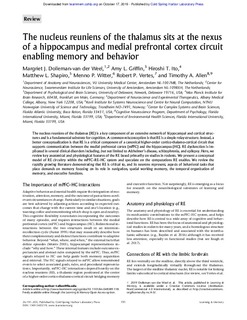| dc.contributor.author | Dolleman-van der Weel, Margriet J. | |
| dc.contributor.author | Griffin, Amy L. | |
| dc.contributor.author | Ito, Hiroshi | |
| dc.contributor.author | Shapiro, Matthew L. | |
| dc.contributor.author | Witter, Menno | |
| dc.contributor.author | Vertes, Robert P. | |
| dc.contributor.author | Allen, Timothy A. | |
| dc.date.accessioned | 2019-10-24T08:20:28Z | |
| dc.date.available | 2019-10-24T08:20:28Z | |
| dc.date.created | 2019-08-27T12:21:55Z | |
| dc.date.issued | 2019 | |
| dc.identifier.citation | Learning & memory (Cold Spring Harbor, N.Y.). 2019, 26 (7), 191-205. | nb_NO |
| dc.identifier.issn | 1072-0502 | |
| dc.identifier.uri | http://hdl.handle.net/11250/2624057 | |
| dc.description.abstract | The nucleus reuniens of the thalamus (RE) is a key component of an extensive network of hippocampal and cortical structures and is a fundamental substrate for cognition. A common misconception is that RE is a simple relay structure. Instead, a better conceptualization is that RE is a critical component of a canonical higher-order cortico-thalamo-cortical circuit that supports communication between the medial prefrontal cortex (mPFC) and the hippocampus (HC). RE dysfunction is implicated in several clinical disorders including, but not limited to Alzheimer's disease, schizophrenia, and epilepsy. Here, we review key anatomical and physiological features of the RE based primarily on studies in rodents. We present a conceptual model of RE circuitry within the mPFC–RE–HC system and speculate on the computations RE enables. We review the rapidly growing literature demonstrating that RE is critical to, and its neurons represent, aspects of behavioral tasks that place demands on memory focusing on its role in navigation, spatial working memory, the temporal organization of memory, and executive functions. | nb_NO |
| dc.language.iso | eng | nb_NO |
| dc.publisher | Cold Spring Harbor Laboratory Press | nb_NO |
| dc.rights | Navngivelse-Ikkekommersiell 4.0 Internasjonal | * |
| dc.rights.uri | http://creativecommons.org/licenses/by-nc/4.0/deed.no | * |
| dc.title | The nucleus reuniens of the thalamus sits at the nexus of a hippocampus and medial prefrontal cortex circuit enabling memory and behavior | nb_NO |
| dc.type | Journal article | nb_NO |
| dc.type | Peer reviewed | nb_NO |
| dc.description.version | publishedVersion | nb_NO |
| dc.source.pagenumber | 191-205 | nb_NO |
| dc.source.volume | 26 | nb_NO |
| dc.source.journal | Learning & memory (Cold Spring Harbor, N.Y.) | nb_NO |
| dc.source.issue | 7 | nb_NO |
| dc.identifier.doi | 10.1101/lm.048389.118 | |
| dc.identifier.cristin | 1719076 | |
| dc.description.localcode | © 2019 Dolleman-van der Weel et al.; Published by Cold Spring Harbor Laboratory Press This article, published in Learning & Memory, is available under a Creative Commons License (Attribution-NonCommercial 4.0 International), as described at http://creativecommons.org/licenses/by-nc/4.0/. | nb_NO |
| cristin.unitcode | 194,65,60,0 | |
| cristin.unitname | Kavliinstitutt for nevrovitenskap | |
| cristin.ispublished | true | |
| cristin.fulltext | original | |
| cristin.qualitycode | 2 | |

